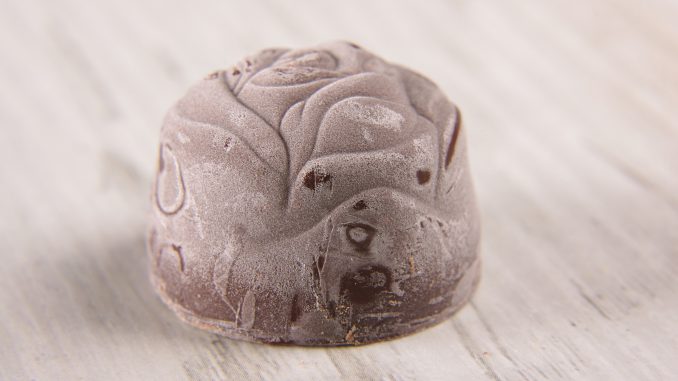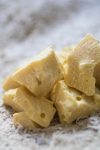
Sometimes, you open a box of chocolates only to be confronted by the sights of a white chalky streak or sheen on all your favourite ones. It doesn’t hurt you to eat them but it tells you that this particular box has not been looked after or the chocolate used was not that high a quality. As we near Valentine’s day, it is not something you want to inflict on your loved one!
What is Fat Bloom?
Fat bloom is a visual condition of chocolate. It is best described as a whitish
surface, a lack of gloss, improper and uncharacteristic snap on cracking and biting and an odd melting sensation when at mouth temperature.
The phenomenon is due to undesirable fat crystallization transition events. It is now accepted that it is caused by the separation of cocoa butter which moves to the surface of the chocolate. Crystallization of cocoa butter fat is at the heart of this phenomenon and one of the focal points for chocolatiers when trying new recipes.
Cocoa butter exists in six different crystal polymorphisms frequently named as γ, α, β'(III), β'(IV), β(V) and β(VI). These are for the record arranged in order of increasing melting temperature and thermal stability (Wille & Lutton, 1966; Chapman et al., 1971).
Fat bloom occurs when fat crystals start to protrude from this surface. These crystals have sizes between 4 and 5 microns. They reflect and scatter incident light and this appears as that thin whitish-like film which is really a haze of fat. It can completely cover the whole surface of the chocolate.
The presence of fat bloom makes chocolate visually unappealing and generally unacceptable to the consumer. It is usually an indicator of poor storage, when there have been significant temperatures differences. Dark chocolate is especially prone to this issue. The fat bloom effect also means that the texture and taste of the chocolate will not be on tip-top form. Fat bloom is not detrimental to human health.
The condition should not be confused with sugar bloom which results from severe changes in humidity. A number of articles have critically examined this phenomenon (Timms, 1984; Lipp & Anklam, 1998; Rousseau, 2007; Beckett, 2008).
The Changes to Fat
The fat bloom is in part due to separation of cocoa butter from other ingredients making up the chocolate. The most sought after crystal form for a well-tempered chocolate is the β(V) crystal form. This particular form has the ideal and most desirable melting behaviour along with a good quality snap and attractive surface gloss. Its continued appearance in chocolate is also down to high quality and managed transportation, storage and presentation usually without uncontrolled temperature changes (Rousseau, 2007).
Bloomed chocolates contain the most stable VI polymorph of cocoa butter. This bloom occurs through the uncontrolled polymorphic transformation of cocoa butter from a lower, less stable form, either form IV or V to its most stable higher form (form VI). The technology of good chocolate production depends on ensuring that only the stable form of the cocoa butter ingredient exists in the final product.
Milk chocolate does exhibit some fat bloom but the proportion of butter fat is this type of chocolate is such that it produces a eutectic effect. This lowers the melting point, causes softening of any texture and a lowering of the crystal seed.
Fat blooms are also found in compound coatings too which always seems surprising because chocolate in the form of cocoa powder is not always added to these coatings.
Preventing Fat Bloom
The best way to prevent fat blooms forming is to first start with the best product that you can afford. Good quality chocolate is a must and it will be more expensive than poorly tempered chocolate. Try to avoid storing any chocolate in parts of the house or car where there will be temperature differences. The best temperature is around low ambient or between 15 and 18 °C. Try to avoid moving the chocolate from hot to cold regions and vice versa. Never freeze chocolate and it doesn’t do it much good storing it in the refrigerator either.
Other approaches to preventing fat bloom involve the modification of chocolate composition. For example, milk fat can replace cocoa butter by delaying fat bloom formation. It does so by slowing down the β(V) to β(VI) crystal transition (Cebula & Ziegleder, 1993; Lohman & Hartel, 1994; Luccas et al., 2014; Sonwai & Rousseau, 2010).
References
Beckett, S. T. (2008). The Science of Chocolate. RSC Publishing (2nd ed.). (Article)
Cebula, D. J., & Ziegleder, G. (1993). Studies of bloom formation using X-ray diffraction from chocolates after long-term storage. Fat Science Technology, 9, pp. 340–343
Chapman, G. M., Akehurst, E. E., & Wright, W. B. (1971). Cocoa butter and confectionery fats. Studies using programmed temperature X-ray diffraction and differential scanning calorimetry. Journal of the American Oil Chemists’ Society, 48, pp. 824–830 (Article)
Lawler, P. J., & Dimick, P. S. (2008). Crystalization and polymorphism of fats. In C. C. Akoh & D. B. Min (Eds.), Food Lipids – Chemistry, Nutrition, and Biotechnology (Third Edit, pp. 245–266). CRC Press
Lipp, M., & Anklam, E. (1998). Review of cocoa butter and alternative fats for use in chocolate—Part A. Compositional data. Food Chemistry, 62(1), pp. 73–97 (Article)
Lohman, M. H., & Hartel, R. W. (1994). Effect of milk fat fractions on fat bloom in dark chocolate. Journal of the American Oil Chemists’ Society, 71(3), pp. 267–276 (Article).
Lonchampt, P., & Hartel, R. W. (2004). Fat bloom in chocolate and compound coatings. European Journal of Lipid Science and Technology, 106(4), pp. 241–274 (Article).
Rousseau, D. (2007). The microstructure of chocolate. In D. J. McClements (Ed.), Understanding and controlling the microstructure of complex foods (pp. 648–690). Woodhead Publishing. (Article)
Sonwai, S., & Rousseau, D. (2010). Controlling fat bloom formation in chocolate – Impact of milk fat on microstructure and fat phase crystallisation. Food Chemistry, 119(1), pp. 286–297 (Article).
Timms, R. E. (1984). Phase behaviour of fats and their mixtures. Progress in Lipid Research, 23, pp. 1–38
Wille, R. L., & Lutton, E. S. (1966). Polymorphism of cocoa butter. Journal of the American Oil Chemists Society, 43(8), pp. 491–496 (Article)

Leave a Reply